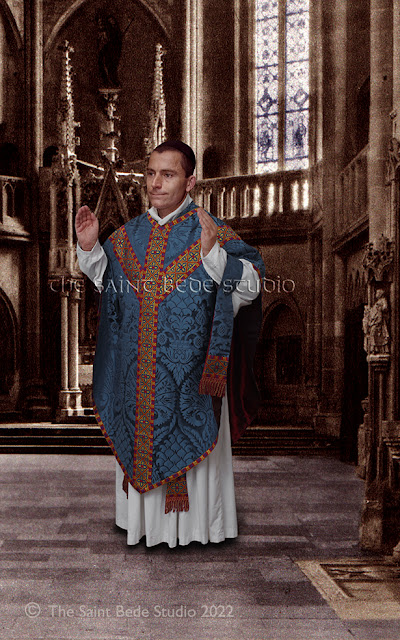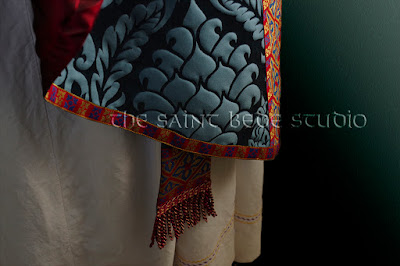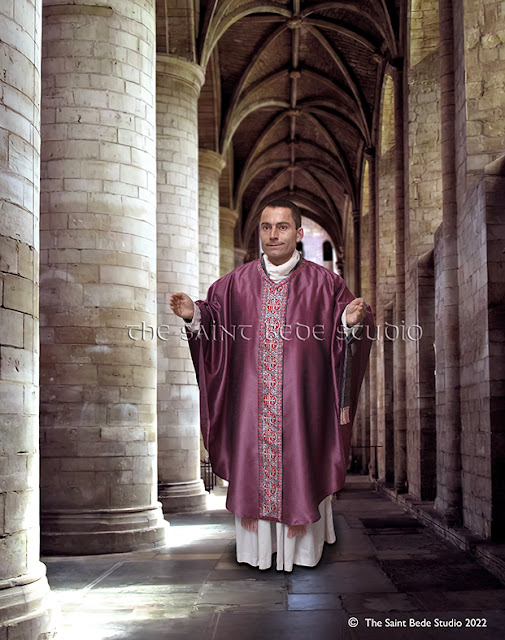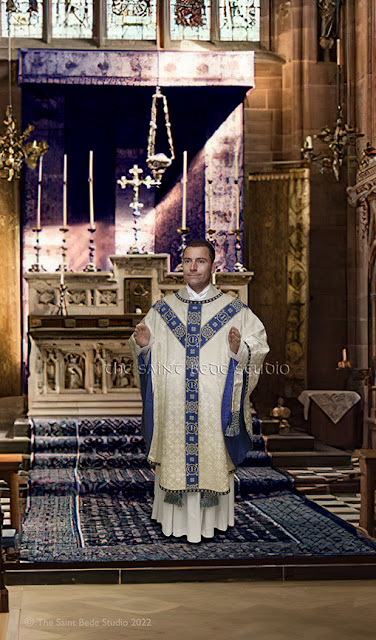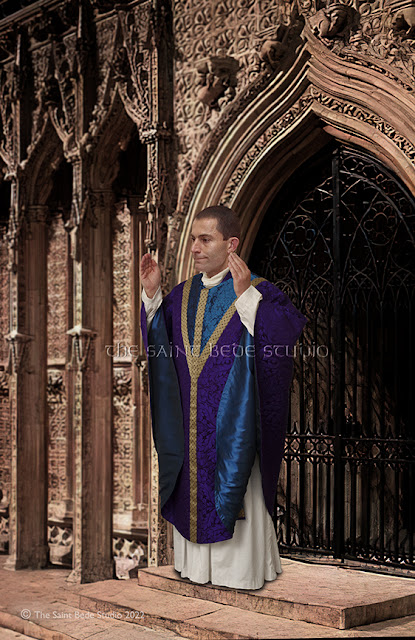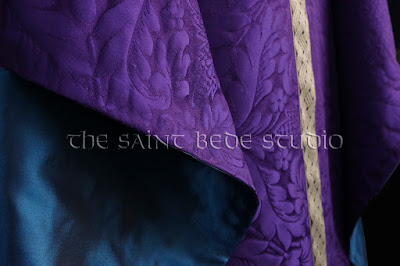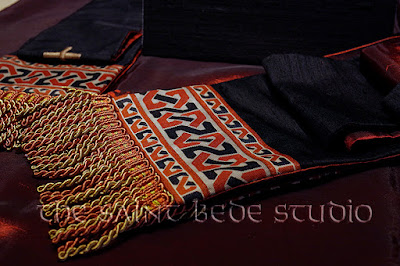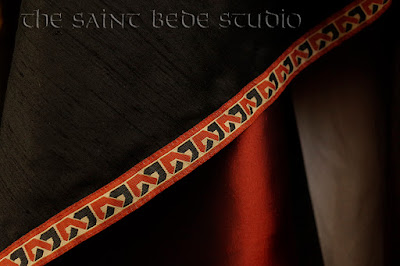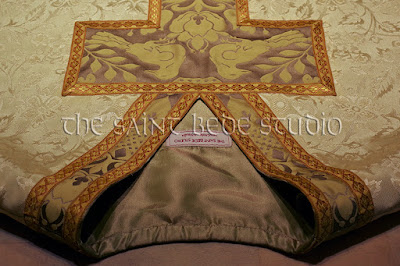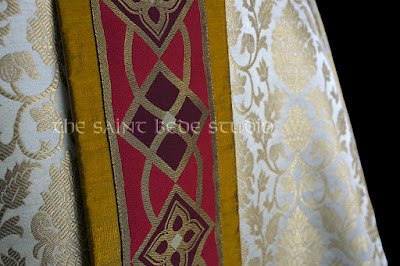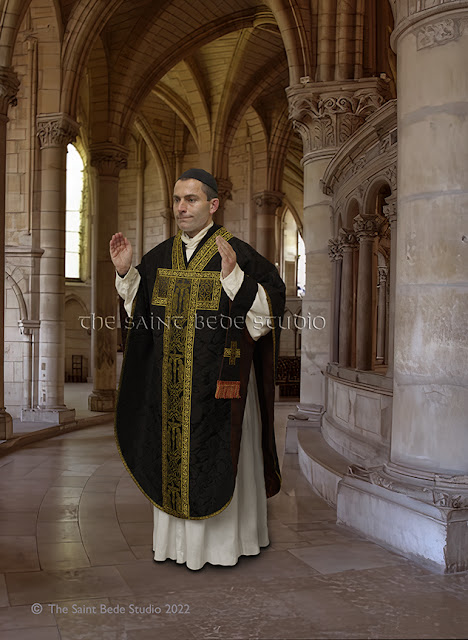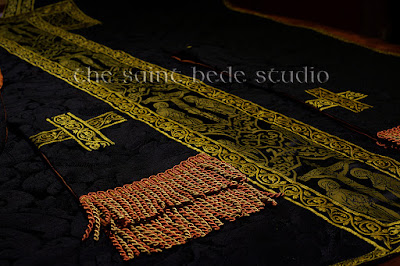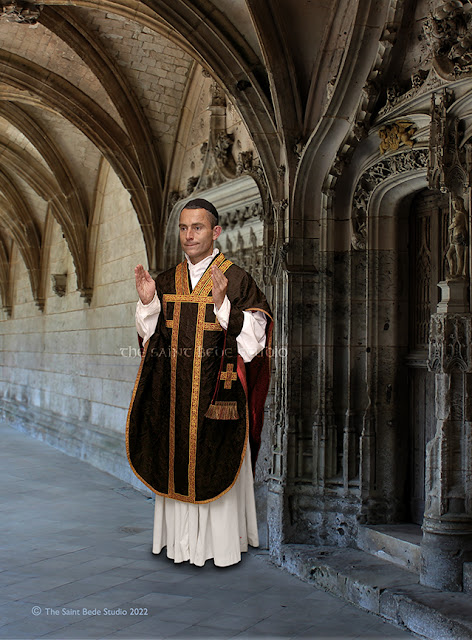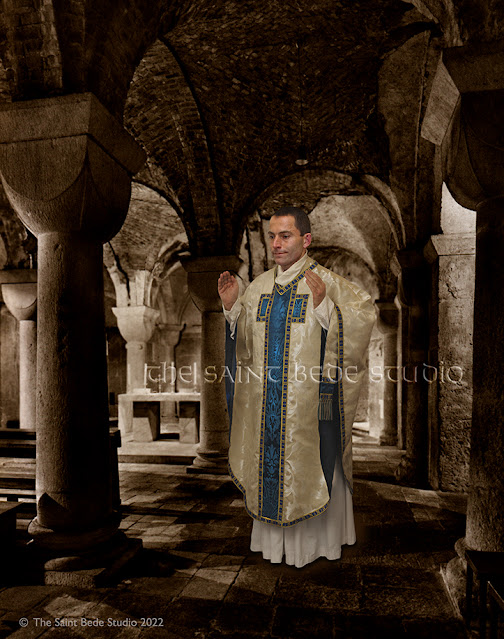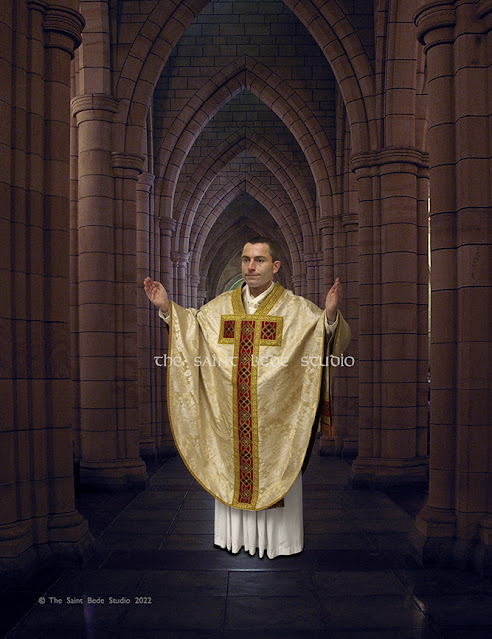 |
| Pope Benedict during Vespers in Saint Peter's 31st December 2011. |
Saturday, 31 December 2022
Our Beloved Benedict XVI
Saturday, 24 December 2022
In this Holy Season 2022
Every valley shall be exalted, and every mountain and hill be made low; the crooked shall be made straight and the rough places, plain; and the Glory of the Lord shall be revealed and all flesh shall see it together, for the mouth of the Lord has spoken it.
Isaiah 40:4-5.
Michael Sternbeck
The Saint Bede Studio
December 2022
Saturday, 17 December 2022
In the Season of Advent : 2
The Liturgy of the Ordinariate communities often incorporates vestiges of the English Sarum Use, which employed a different set of liturgical colours from those of the Roman Rite.
These particular vestments were made for use during the Season of Advent and were fashioned from an English silk damask in a beautiful and subtle shade of blue. The ornament was formed one of the Studio's unique braids, based on a geometric design of AWN Pugin, in colours of blue and straw-gold upon red. The vestments were fully lined in a lovely shade of deep red taffeta.
These vestments are in the Studio's Saint Austin form which is pointed at the front and the back in the Gothic Revival style.
Please click on the images for an enlarged view.
Enquiries : This page.
Saturday, 10 December 2022
Gaudete Sunday 2022
The chasuble is unlined, but is faced at the neckline, helping it to sit well and not crumple. The chasuble is lightweight, has a slight sheen, has good drapery and is comfortable to wear.
This chasuble is part of a range of economy vestments, which we call our Saint Anselm style.
Enquiries : stbede62@gmail.com
Click on the images for an enlarged view.
Thursday, 8 December 2022
On the Immaculate Conception
Sunday, 4 December 2022
Advent Blue (re-posted)
 In this Season of Advent, a debate regularly emerges about the use of "blue" vestments. The use of blue has advocates and fierce opponents.
In this Season of Advent, a debate regularly emerges about the use of "blue" vestments. The use of blue has advocates and fierce opponents. Exactly what colour, however, is being suggested as Advent "Blue"? Is it the same colour as the flowers called "violets"? If so, then using that colour in Advent is not only permissible, but is embedded within the Church's Traditions. Some years ago, we presented an article about the history of the use of "violet" for vestments of the Roman Rite.
Click the links for Part One of the article and Part Two of the article.
In the adjacent illustration, a prelate of the Roman Court is shewn wearing choir dress. What is distinctive is that the colour of the prelate's mantaletta is not the Roman purple that is familiar now for prelates, but violet. Up until the beginning of the 20th century (and even beyond in some places, such as France), violet was very common - even usual - for the choir dress of prelates. Perhaps we may be permitted to regret that it no longer is.
This colour is the more traditional shade of "violet" used by the Church, despite the prevalence of darker shades now, which are more akin to "indigo".
Thursday, 1 December 2022
In the Season of Advent : 1
The vestments were made from an ecclesiastical brocade in a deep shade of violet. A deep, narrow chevron formed from Peacock blue brocade was framed with a galloon comprised of knotwork in black upon a taup background. This formed the chasuble ornament, front and back. The vestments were fully lined in a lovely teal-blue taffeta.
These vestments are in the Studio's Vezelay form which is ample, but carefully shaped to avoid falling upon the wearer like a blanket.
Please click on the images for an enlarged view.
Enquiries : This page.
Thursday, 17 November 2022
In the Month of the Holy Souls : 2
The vestments were made from black dupion silk. A chevron formed from black brocade was framed with one of the Studio's galloons called Saxony, comprising knotwork in burnt orange and black upon a taup background. This formed the chasuble ornament, front and back. The vestments were fully lined in a bronze-coloured taffeta.
These vestments are in the Studio's Saint Martin form which is very ample, but carefully shaped to avoid falling upon the wearer like a blanket.
Please click on the images for an enlarged view.
Monday, 14 November 2022
Saint Philip Neri vestments
Friday, 11 November 2022
Festal Vestments
The vestments were made from a jacquard in colours of ivory and gold and ornamented with a column orphrey, front and back. The ornament was formed from dupion silk in a shade of old gold and one of the Studio's unique braids Saint Columba.
The vestments were fully lined in a brassy-gold colour of taffeta.
Thursday, 10 November 2022
In the Month of the Holy Souls
Please click on the images for an enlarged view.
Friday, 4 November 2022
Walking to Heaven Backward
 |
| Figure 1. The celebration of Mass "ad orientem" according to the New Missal in a French Monastic Community. |
He [Newman] was reminding us that, in fact, we all make mistakes about the meaning of life and how it should be lived. But things do not stop there because we then go on to act out these mistaken ideas, and this is true even if or when we are not very clear as to what exactly the ideas are. Bad practice is based on confused and false principles, and it is by an often bitter experience that we finally see the truth a bit more clearly and so find ourselves a little nearer to the Promised Land. EN2
We advance to the truth by experience of error; we succeed through failures. We know not how to do right except by having done wrong. We call virtue a mean, that is, as considering it to lie between things that are wrong. We know what is right, not positively, but negatively; we do not see the truth at once and make towards it, but we fall upon and try error, and find it is not the truth. We grope about by touch, not by sight, and so by a miserable experience exhaust the possible modes of acting till naught is left, but truth, remaining. Such is the process by which we succeed; we walk to Heaven backward.
Saint J.H. Newman "Parochial and Plain Sermons" Vol. 5, no. 8.
 |
| Figure 2. A scene at the Second Vatican Council. |
EN1 Robinson, Jonathon, The Mass and Modernity : Walking to Heaven Backward, Ignatius Press, San Francisco 2005.
EN2 Robinson, op.cit., page 344.
EN3 The terms Ordinary and Extraordinary as applied to the Mass of the Roman Rite originated in 2007 with Pope Benedict's motu proprio Summorum Pontificum. In this essay, we will refer to the Ordinary form as The Revised Rites since we are also discussing the revised liturgical books of the Sacraments, Episcopal ceremonies &c.
EN4 The following article is an investigation of the words written by the then Cardinal Ratzinger : https://sharonkabel.com/post/ratzinger-fabricated-liturgy/
AMDG
Wednesday, 2 November 2022
The Commemoration of All the Faithful Departed
The vestments are extremely simple, but in the classic Roman style of ornament. A black damask was used for these vestments, ornamented with braids in burgundy and gold and lined in wine-red taffeta.
Please click on the image for an enlarged view.
Enquiries : stbede62@gmail.com
Monday, 31 October 2022
The month of October
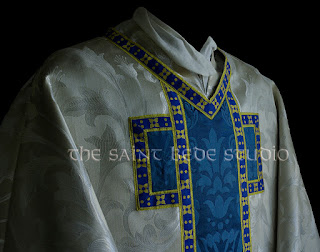 |
The vestments were made from a brocade with a large-scale woven design in the colour of ivory. The front of the chasuble was ornamented with a stylised form of the Roman TAU, but the back of the chasuble was formed into a Cross.
AMDG
Wednesday, 26 October 2022
Jubilee Vestments
 |
| Mass celebrated in Saint Mary's Cathedral Sydney celebrated by Archbishop Fisher OP. |
These ample vestments were made from a lovely silk brocade in colours of white and muted gold. They were ornamented in the Roman manner with a TAU formed from one of the Studio's braids, Saint Columba, outlined with a golden galloon. The vestments were fully lined in a rust red taffeta.
Please click on the images for an enlarged view.
Enquiries : Visit this page
 |
| Before Mass in Saint Mary's Cathedral, the Archbishop of Sydney blessed the new vestments. |
 |
Monday, 24 October 2022
Bi-centenary of Saint Mary's Cathedral Sydney 1821 - 2021
The editor of this blog was approached to assist the staff of the newspaper of the Archdiocese of Sydney The Catholic Weekly in the preparation of a special edition commemorative of the Bi-centenary of Saint Mary's Cathedral.
This commemorative edition has now been published and an online version of it may be viewed here.
 |
| Old Saint Mary's as it appeared in the early 1840s. Image : The Saint Bede Studio |
Four special articles were written about old Saint Mary' Cathedral (1821-1865). Some of the information has already appeared on our other Catholic history blog In diebus illis, but special images were prepared to illustrate the articles.
Since every word had to count in limited print space, I was not able to mention those who assisted me in this project. I wish to do so here.
Mr Brian Andrews of Tasmania
Dr Lienntje Cornelissen, Sydney Archdiocesan Archivist
Mr Giovanni Portelli, Catholic photographer
The Very Rev'd Donald Richardson, Dean of Saint Mary's Cathedral
Staff of Special Collections, State Library of New South Wales
Mr Simon Fieldhouse, Sydney artist
Prof. James Franklin, Vice-President of the Australian Catholic Historical Society.
Mr Peter Rosengren, editor of the Catholic Weekly.
The Friends of Saint Mary's Cathedral.
Various encouragers known to the editor.
AMDG
Saturday, 22 October 2022
ORDINANDS 2023
2023 is not far off, so if you are interested in commissioning vestments with the Saint Bede Studio for your Ordination next year, NOW is the time to contact us to begin discussions.
Every year - regretfully - we have to refuse work from ordinands because they have left enquiries too late for us to fit into our over-crowded schedule.Contact us now to avoid disappointment.
Enquiries : stbede62@gmail.com
Tuesday, 18 October 2022
Gothic Revival Festal Vestments
This chasuble was tailored in the Studio's Saint Giles design, a variant on the Gothic Revival chasuble. The vestments were made from a brocade in colours of ivory and burgundy upon old gold. They were lined in red taffeta.
The vestments were ornamented with an orphrey braid of the Studio's own design in colours of red and gold upon blue. The braid called Saint Chad is directly based on a design by AWN Pugin.
Click on the images for an enlarged view.
Enquiries : Visit this page




